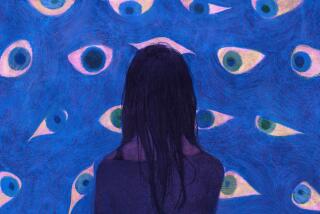In blurred hindsight, a work-life balance is the clear choice
- Share via
I checked my watch. Perhaps if the traffic was light I’d have time to stop off in Malibu for a low-carb breakfast. I blinked rapidly a few times; for some reason, I couldn’t read my watch. My left eye -- the one I used for close-up work and reading -- seemed to have a rippled curtain hanging in front of its field of vision, and even intensive blinking couldn’t sweep it aside.
Turning my gaze back to the road ahead, I closed first one eye, then the other. Nope, the curtain was still there in only the left eye. The lanes of the freeway in front of me had become tortuous. My smooth, relaxing coastal sojourn toward my lecture in Ventura would not be such an easy drive after all.
With a sinking feeling, I remembered that I had experienced some unusual flashing lights in the affected eye the night before. Busy preparing my talk on “workaholism,” I had forced myself to ignore what I told myself was just probably an aura -- a visual light show that sometimes preceded my occasional migraines.
But the migraine never had developed. Were last night’s lights a transient ischemic attack (a temporary stroke), or a prelude to a full-blown stroke? Was I having a stroke at this very moment? But I was too young.... wasn’t I?
I reassured myself that 90% of strokes occur in people older than 55, so I still had a few years to go. As I passed the Santa Monica Freeway’s Cloverfield/26th Street exit to my right, I tried to deny my knowledge that strokes have occurred in people far younger than me. After all, I had no other symptoms. Just that blasted curtain, dimming and distorting my view.
No, it wasn’t a stroke, I told myself. I felt fine, I felt fine. But another potential diagnosis hammered at me -- retinal detachment.
I had just had surgery on my left eye the month before. After an uncomplicated and wonderful LASIK procedure a few years ago, I had begun to notice that my left eye had grown very nearsighted again in the last six months. Thinking I might need a touch-up on my LASIK, I was stunned to hear that I had an unusual type of cataract in that eye, whose presence, my eye doctor explained, was probably due to a congenital cause, i.e. fated from birth. My doctor had performed a relatively simple cataract extraction and replaced the cataract with a new, plastic lens, through which I could once again see clearly. Until now.
Flashing lights, rippled curtains -- these could be symptoms of a separation of the retina (the “film” of an eye camera) from the outside wall of the eye, the sclera. Untreated, a retinal detachment can lead to permanent loss of vision. It can also be a complication after cataract surgery.
I was approaching the 5th Street exit, and, despite the potential risks, still struggling with a choice. With my right eye -- the one I use for distance and driving -- I could still drive relatively safely, I was certain, and so make it to my seminar, give my lecture, and then go see the eye doctor. There would be at least 50 people waiting for me, interested in my insights on workaholism and its effect on health. I couldn’t let them down. I had a professional commitment, and my eye could wait. But if it was a retinal detachment, even minutes would count.
Workaholism lecture or potential loss of vision? Lecture loss of vision? The irony didn’t escape me.
Like many women today, frantically juggling family and professional responsibilities, making time for my own needs was not at the top of the priority list. But in the end, I couldn’t avoid listening to the advice I was going to give others -- to avoid sacrificing one’s health at the altar of work. I turned off onto 5th Street and made my way to the emergency room a few blocks away. Within an hour, I was in the hands of the retinal specialist, my eyes dilated for him to examine.
The news was relatively good. I had a detachment of the vitreous, a jelly-like substance that sits between the lens and the retina and optic nerve. My symptoms, which now included gray spots in the shape of the Caribbean islands in my field of vision, would be permanent, but, the specialist reassured me, would become less noticeable with time.
I was relieved to hear that my retina had been spared, though, even now, many months later, I can’t quite say I’m used to the changes in my once crystal-clear vision.
However, I am aware how close, just as so many others have done, I came to choosing my work over my health. In hindsight, I probably could have waited until after my lecture to see the eye specialist. But the consequences of waiting could easily have been tragic.
When I finally was able to call and cancel my talk that morning, my audience was kinder to me than I had been to myself, sending me warm expressions of concern and support for my quick recovery. The conference organizers were very understanding, and I was able to reschedule my talk for a future date. My fears that my colleagues would be disappointed in me for choosing to care for my health had been unfounded.
A few months later, I finally gave the workaholism lecture, telling my audience with newfound conviction that we should all strive for work-life balance. It not only leads to more productive work, I said, but also a longer and happier life.
*
Dr. Linda Reid Chassiakos is director of the Klotz Student Health Center at Cal State Northridge and a clinical assistant professor of pediatrics at UCLA.


